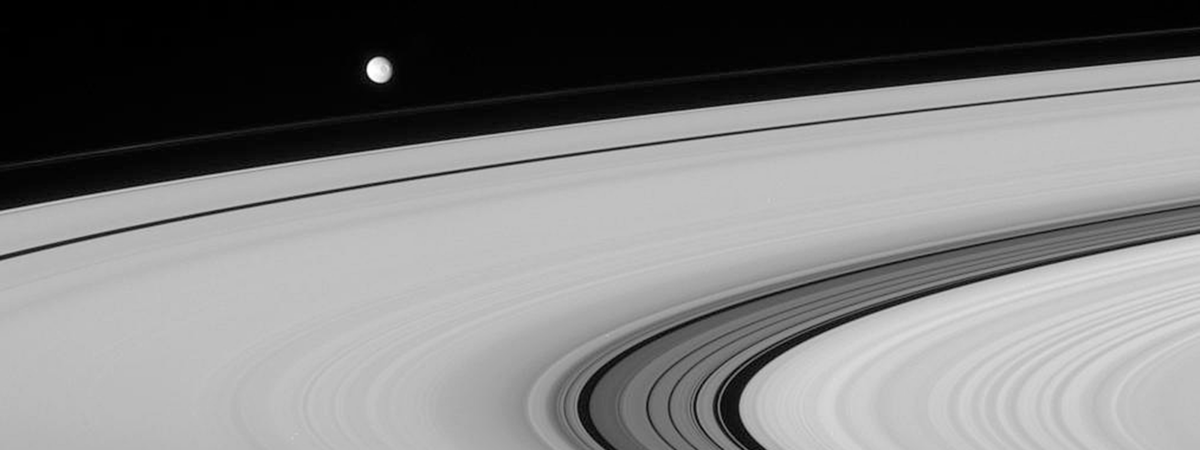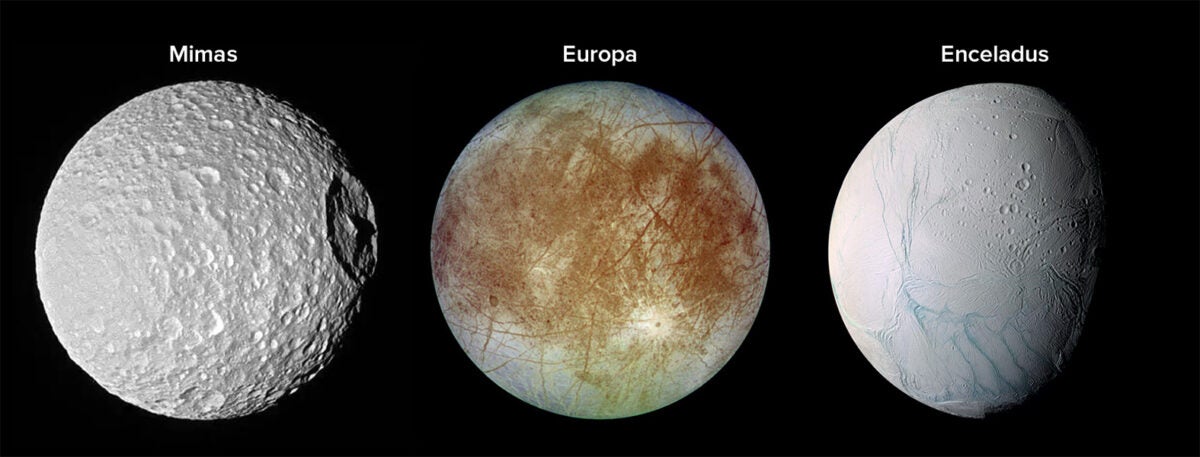
Saturn’s moon Mimas, floating above the planet’s rings, might conceal a liquid ocean beneath its surface. Credit: NASA/JPL/SPACE SCIENCE INSTITUTE
The outer solar system is awash with liquid water. A briny ocean is concealed beneath the icy crust of Jupiter’s fourth largest moon, Europa — with more water than all of Earth’s oceans combined. A subsurface sea on Saturn’s moon Enceladus spews plumes of water vapor into space. And there are tantalizing hints that oceans could exist on Ganymede, Callisto, Titan and other distant moons, too.
Now another moon appears to be secretly flooded. Saturn’s moon Mimas, known for its uncanny resemblance to the Star Wars Death Star, might harbor liquid water beneath its icy shell. If true, similar seas could be hiding in plain sight, and the outer solar system may be far more habitablethan previously thought.
In 2014, scientists first published evidence that Mimas might be a watery world — submerging the community in a decade-long debate. Many, including Alyssa Rhoden, a planetary scientist now at the Southwest Research Institute in Boulder, Colorado, were highly skeptical of the possibility. Their reasoning was simple: Mimas’ heavily cratered surface showed no signs of an internal ocean. As with Enceladus, Saturn’s gravity should churn the ocean waters within Mimas, causing large cracks to appear in the surface ice. No such fractures have been seen.

The tides might now have turned. Two studies, one by Rhoden and colleagues and another by Valéry Lainey of the Paris Observatory and colleagues, make a stronger case for an ocean and even explain the conundrum at the surface. Together, the research suggests that Mimas may have a young and changing ocean. If so, it raises the prospect of an outer solar system rife with activity. That possibility is what most excites Rhoden, who spoke with Knowable Magazine about the potential ocean and why it could be such a boon for scientists.
This conversation has been edited for length and clarity.
What do we know about these hidden oceans?
In many ways, they look like our own — at least in that they’re likely made up of saltwater.
We know that these ocean worlds have icy surfaces from their overall bright appearance, as confirmed by telescopic and spacecraft measurements that detect signatures of water ice. Some ocean moons even have low enough densities that they probably have water ice mixed into the rock in their interiors. With heat, that water ice melts into liquid water, which will erode rock to create saltwater. On Enceladus, saltwater is conveniently spewing out into space.
Given how cold it is in the outer solar system, what generates the heat?
Distant oceans might at first seem out of the question. Heat to melt ice is hard to come by so far from the Sun. But thanks to a gravitational quirk, the outer solar system can be quite balmy.
Consider Jupiter and its moon Europa. Jupiter exerts a strong gravitational force on Europa, elongating Europa in the direction of Jupiter. Because Europa’s orbit is eccentric — it swings close to Jupiter before swinging farther away — Europa gets stretched and released over time. This creates friction in the interior that provides the heat necessary to sustain a liquid ocean.
We first saw hints that Europa might host a subsurface ocean when the Voyager mission swung past Jupiter in 1979. Europa doesn’t look like our Moon or even most bodies in the inner solar system. Its icy surface doesn’t have a lot of craters but is instead covered with crisscrossing lines and broken pieces that have shifted around. You don’t have to look at it very hard to imagine that something different is going on there.

You mention surface features. What other evidence do we rely on to detect a hidden ocean?
One way is to look at magnetic fields. Because saltwater is electrically conductive, it can create a magnetic field around the moon that disrupts the planet’s magnetic field. That is a leading piece of evidence for Europa’s subsurface ocean.
But that alone is not enough. It’s the combination of evidence that leads us to conclude there’s an ocean. We might also consider, for example, measurements of salt on the surface and how the moon’s gravity tugs on a spacecraft. Since the densities of rock or liquid metal differ from the density of liquid water, the size of those tugs offers clues to the material, as well as where within the moon it is concentrated.
Or we might simply image how the moon’s face changes direction throughout its orbit. Generally, these small moons always show their same face to their parent planet, much like our Moon. But as a moon moves through its orbit, the direction it points can shift a bit back and forth — creating a shimmy in the visible portion. The extent of that shimmy depends on the interior. An ice shell over an ocean can move more freely than an ice shell on top of rock, so the changes tend to be larger. That’s how the ocean was detected at Enceladus. And it’s one of the best lines of evidence for an ocean at Mimas.
Let’s talk about Mimas. How did you end up studying the moon?
I had spent a decade or so working on Europa and other icy moons when the 2014 Mimas paper came out. That paper measured that shimmy, or libration, as the visible portion of the moon shifts, suggesting Mimas either hosted a subsurface ocean or an oddly shaped core.
But an ocean seemed impossible. Mimas looks much like our Moon, with a heavily cratered surface. It didn’t host any crisscrossing lines or broken pieces like Europa. And it certainly wasn’t spewing geysers like Enceladus. So I took one look at Mimas, and I said, “There’s no way that is an ocean moon.” Yet I realized I couldn’t refute the idea.
I kept Mimas in my mind over the years, eventually putting together a paper for the Annual Review of Earth and Planetary Sciences in 2023. That paper ruled out several ocean scenarios and left only one option, an ocean that formed recently, well after Mimas itself. A young ocean could be stealthy. But it was still just a hypothesis.
How has the most recent work changed the picture?
Early in 2024, Valéry Lainey and his group reported new observational evidence in favor of an ocean on Mimas. They looked not at the libration but at changes in Mimas’ orbit through time — changes that depend on the interior structure. They found that those changes could not be explained by an oddly shaped core, leaving an ocean as the most viable option.
My team’s research, published in June, has gone on to explain the lack of visible surface fractures. We argue that the ocean is so young — merely 10 million years old — that it has only recently stopped growing. We think that the tidal stresses of a young churning ocean may not be enough to crack the ice above. Instead, what’s needed is the stress that comes when the ocean eventually refreezes. Because Mimas is losing heat as its orbit becomes less eccentric over time, refreezing — which is only just beginning on Mimas — will cause the overlying ice to crack.
The research suggests that eventually Mimas is probably going to lose its ocean, which is a little sad, since it is just being recognized. But on the flip side, Mimas may become the new Enceladus — the new coolest moon of Saturn — with deep cracks and maybe even jets of water.
What are the big picture implications of this research?
I’m interested in this from a geophysical standpoint. We think of the earliest epochs in our solar system as the hot times, when all the activity happens, then everything evolves toward a quieter state. Pluto’s moon Charon might have lost an ocean. And Europa’s and Ganymede’s oceans are pretty old. That a moon could form a new ocean well into its history, and that we could watch? That’s exciting! It opens up the possibility that any world, including one with an old, cratered surface, may be going through a similar transition.
There’s also interest in habitability — whether these oceans are suitable for supporting life. We don’t currently know whether any of the solar system’s oceans, other than our own, are habitable, have been inhabited or are currently inhabited. But if Mimas truly has an ocean, we could have a window into how these worlds develop and even how habitats are created and lost. It is exciting to be able to see these processes as they occur — instead of always viewing the end states of things that happened long ago.
What upcoming missions could tell us more?
The European Space Agency has already launched the Jupiter Icy Moons Explorer, or Juice, which will make detailed observations of Europa, and the moons Ganymede and Callisto, which show hints of oceans. And in the fall of 2024, NASA will send the Europa Clipper into orbit around Jupiter to determine if Europa has conditions suitable for life.
The Uranus system, high on NASA’s agenda for a future mission, is where I see the most implications for this recent work. It’s surprisingly similar to the Saturn system, including hosting ice-rich, mid-sized moons similar to Mimas and Enceladus. If there’s a young ocean on Mimas, it is not a huge leap to consider that water worlds might exist among the Uranian moons, too.
10.1146/knowable-080724-1
Shannon Hall is an award-winning freelance science journalist based in the Rocky Mountains. She specializes in writing about astronomy, geology and the environment.
This article originally appeared in Knowable Magazine, an independent journalistic endeavor from Annual Reviews. Sign up for the newsletter.

